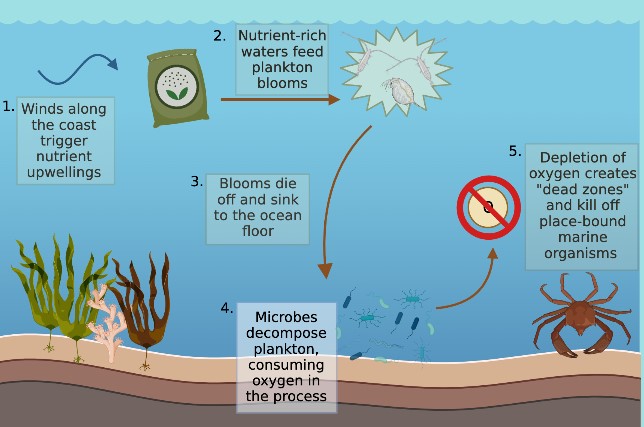Much like Oregon’s forests experience wildfire seasons, the waters off the Oregon coast experience what are called “hypoxia seasons”. During these periods, which occur in the summer, northern winds bring nutrient-rich water to the Eastern Current Boundary off the Oregon Coast. While that might sound like a good thing, the upwells bring a bloom of microscopic organisms such as phytoplankton that consume these nutrients and then die off. As they die off, they sink and are then decomposed by marine microorganisms. This process of decomposition removes oxygen from the water, creating what’s called an oxygen minimum zone, or OMZs. These OMZs can span thousands of square miles. While mobile organisms such as fish can escape these areas and relocate, place-bound creatures such as crabs and bottom-dwelling fish can perish in these low oxygen zones. While these hypoxia seasons can occur due to natural phenomena, stratification of the water column due to other factors such as climate change can increase the frequency or severity of these seasons.

2021 was one of the worst years on record for hypoxic waters off the Western coast of the United States. A major contributing factor was the extremely early start to the upwelling triggered by strong winds. Measurements of dissolved oxygen and ocean acidity were high enough to be consistent with conditions that can lead to dead zones, and this is exactly what happened. Massive die-offs of crabs are concerning as the harvesting of Dungeness crab is one of the most lucrative fishing industries in the state. Other species and organisms move into shallower waters, disturbing the delicate balance of the coastal ecosystems. From the smallest microbe to the largest whale, almost every part of the coast can be affected by hypoxia season.
Our guest this week is Sarah Wolf, a fourth year PhD candidate in the Department of Microbiology here at Oregon State. Sarah, who is co-advised by Dr. Steve Giovannoni and Dr. Francis Chan, studies how microbes operate in these OMZs. Her work centers around microbial physiology and enzyme kinetics, and how these things change over time and in varying oxygen concentrations. To do this, she spent her second year developing a mesocosm, which is a closed environment that allows for the study of a natural environment, which replicates conditions found in low oxygen environments.
Her experiments involve hauling hundreds of liters of ocean water from the Oregon coast back to her lab in Nash Hall, where she filters and portions it into different jugs hooked up to a controlled gas delivery system which allows her to precisely control the concentration of oxygen in the mesocosm. Over a period of four months Sarah samples the water in these jugs to look at the microbial composition, carbon levels, oxygen respiration rates, cell counts, and other measures of the biological and chemical dynamics occurring in low oxygen. Organic matter can get transformed by different microorganisms that “eat” different pieces through the use of enzymes, but many enzymes which can break down large, complex molecules require oxygen, and in low oxygen conditions, this can be a problem for the breakdown and accumulation of organic matter. This is the kind of phenomenon that Sarah is studying in these mesocosms, which her lab affectionately refers to as the “Data Machine”.
Sarah’s journey into science has been a little nontraditional. A first generation college student, she started out her education as a political science major at Montana State before moving to the University of the Virgin Islands for a semester abroad. At the time she wasn’t really sure how to get into research or science as a career. During this semester her interest in microbiology was sparked during an environmental science course which led to her first research experience, studying water quality in St. Thomas. This experience resulted in an award-winning poster at a conference, and prompted Sarah to change her major to Microbiology and transfer to California State University Los Angeles. Her second research experience was very different – an internship at NASA’s Jet Propulsion Laboratory studying cleanroom microbiology, which resulted in a publication identifying two novel species of Bacillus isolated from the Kennedy Space Center. Ultimately Sarah’s journey brought her here to Oregon State, which she was drawn to because of its strong marine microbiology research program.
But Sarah’s passion for science doesn’t stop at the lab: during the Covid-19 pandemic, she began creating and teaching lessons for children stuck at home. During this time she taught over 60 kids remotely, with lessons about microbes ranging from marine microbiology to astrobiology and even how to create your own sourdough starter at home. Eventually she compiled these lessons onto her website where parents and teachers alike can download them for use in classrooms and at home. She also began reviewing children’s science books on her Instagram page (@scientist.sarahwolf), and inviting experts in different fields to participate in livestreams about books relating to their topics. A practicing Catholic, she also shares thoughts and resources about religion and science, especially topics surrounding climate science. With around 12k followers, Sarah’s outreach on Instagram has certainly found its audience, and will only continue to grow.
If you’re curious about microbes in low oxygen conditions, what it’s like to be a science educator and social media influencer, or want to hear more about Sarah’s journey in her own words, tune in at 7 PM on March 13th to catch the live episode at 7 PM PST on 88.7 FM Corvallis, online at https://kbvrfm.orangemedianetwork.com – or you can catch this episode after the show airs wherever you get your podcasts!
